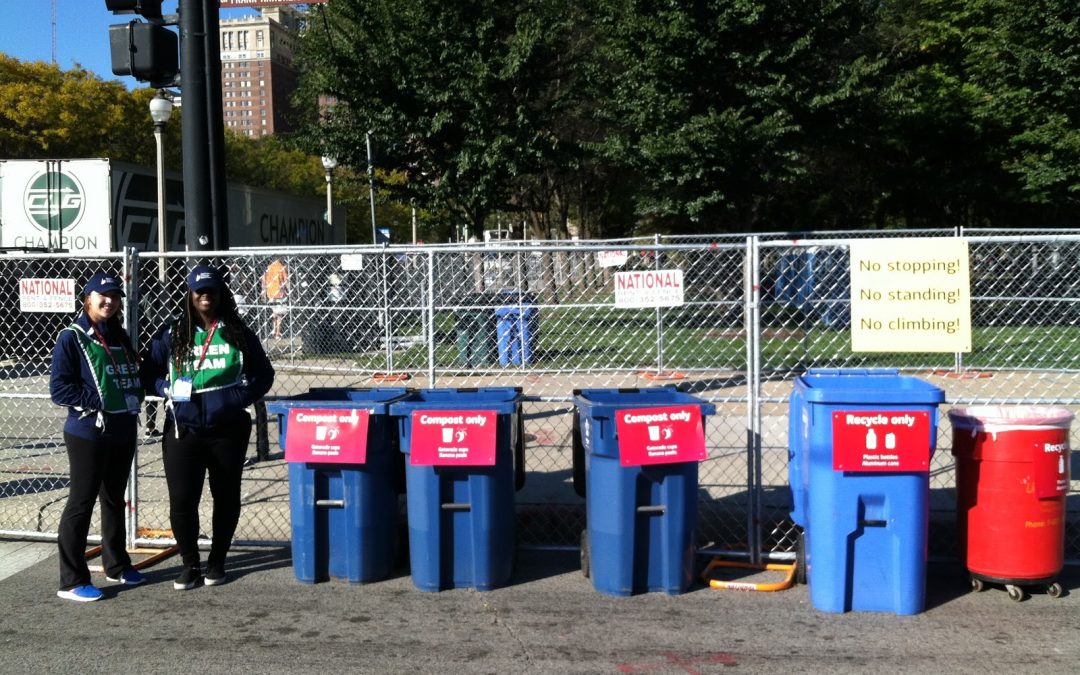By: May-May Chen
Running is one of the greenest sports on this planet. You can do it anywhere at any time, and, unlike other sports, it doesn’t require any equipment, electricity or gasoline. But when 40,000 runners, 1.7 million spectators, and over 100 volunteer groups converge in the third largest city in the United States to participate in the Chicago Marathon every year, the environmental impact of this seemingly low-carbon sport becomes a completely different story [1]
Sports sustainability has recently become a focus for major sports organizations, because of the immense amount of resources and waste that go in and out of large-scale events. Over the past 5 years, the crew behind the annual Bank of America Chicago Marathon has embraced this challenge, and has taken numerous steps to incorporate environmentally and socially responsible practices in the planning, preparation, and execution of its event. In 2010, the Chicago Marathon received its first Council for Responsible Sport certification, and it most recently received its silver certification for the 2014 marathon, making it the largest marathon in the world to be certified today [2].
As a Finish Line Sustainability Coordinator for the Chicago Marathon this year, I had the opportunity to experience just how challenging it is to reduce the overall footprint of a full day event. Everything from paper cups and plastic bottles, to banana peels and reversible heat sheets, to lost and found clothing items and even leftover finisher’s medals must be properly sorted after the race. Because different materials must be treated differently and taken to separate plants, the logistical planning needed to responsibly clean up after the race is immense. But the results of these efforts are astounding: in 2014, for example, over 25,000 pounds of leftover, untouched food and water was donated to the Greater Chicago Food Depository post-race, 3 truckloads of abandoned clothing collected at the starting point were donated to the Pacific Garden Mission and AmVet, and Aid Station material diversion rate increased by over 30% from 2011 to 2013 [2].
Sustainability efforts are not only limited to race day. Since 2012, the Chicago Marathon’s main warehouse facility has been incorporating renewable energy technology into its operations. Traditional marketing and information dissemination strategies have also become increasingly digitized, cutting significant amounts of paper waste in areas such as online registration and finishers certificates [2].
Despite the significant progress made towards the event’s overall reduction in carbon footprint, the Chicago Marathon team, like many other marathon teams, has and is still facing many challenges in implementing its plans. For example, even with 50 Green Team Finish Line volunteers lined up along trashcans in bright green vests, it was difficult to attract everyone’s attention and direct the runners towards the appropriate bins. As a runner myself, I understand how marathoners would not be concerned about stopping to separate their waste into various recycling and composting bins after a long race. In addition, educating and coordinating details about sustainability plans among thousands of event staff and volunteers was very difficult, simply because there were so many people involved.
Despite these challenges, the Chicago Marathon has already made huge strides in reducing its carbon footprint, thanks to a team of highly committed staff and generous support from the rest of the community. Large sporting events like the Chicago Marathon present great opportunities to advocate the importance of environmental sustainability and social responsibility through sports.
[1] Ray Justin, “2015 Chicago Marathon: By the Numbers,” NBC News, October 18,http://www.nbcchicago.com/news/local/2015-Chicago-Marathon-By-the-Numbers-329956491.html
[2]”Sustainability,” Bank of America Chicago Marathon, October 18https://www.chicagomarathon.com/event-information/sustainability/

